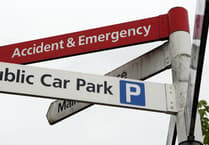A public meeting was held in Buckfastleigh to discuss plans to process up to 90,000 tonnes of incinerator ash and demolition waste at Whitecleaves Quarry. The meeting was organised by Buckfastleigh Community Forum.
Under the plans, incinerator residue from a giant waste to energy plant, that MVV Environment seeks to build at North Yard, Devonport Dockyard, would be processed in the quarry. MVV Environment Devonport Ltd submitted plans to build the incinerator, capable of burning up to 265,000 tonnes of waste a year, to Plymouth City Council last month. A decision is expected in August. Up to 65,000 tonnes of bottom ash a year would be trucked into the town to be mixed with up to 25,000 demolition waste brought in by Gilpin Demolition, the quarry operators, and other contractors. Chairman Neil Smith says he sees the Forum's role as providing information so that residents can make up their own minds about it.
'My feeling is that the more people understand it, the more they're going to be against it because the reality is that it's not a good development. 'For a handful of jobs, it could potentially destroy the town. 'It's good if you work there, or if you own the quarry and can raise the value of the lease and it's good if you sell Yorkie bars to truckers but beyond that there's no benefit to the town at all. 'There are lots of detrimental impacts: the traffic, the noise, the dust, the fumes, the blasting.' Since their first consultation, MVV have doubled the estimated number of lorry movements from 50 to around 100 and Mr Smith believes that could still be an underestimation. 'Dartmoor National Park Authority lists 24 tourist sites across Dartmoor and five of them are within walking distance of Buckfastleigh. You can imagine tourists driving in, seeing dozens of trucks passing and thinking, I don't want to spend too much time here.' Claims that the incinerator residue is harmless also need to be treated with caution, he believes.
'They've got no idea what is going to go into that incinerator and the waste partnership [South West Devon Waste Partnership, which is behind the incinerator bid] specifically told them they are going to have to burn anything that they want them to. It's classed as municipal waste but you don't know if car batteries are being thrown in or if a dodgy builder is getting rid of a bit of asbestos.' Andrew Smith, of MVV, said that the ash would be deposited in the open in piles of up to 8m high, to 'mature' for about a month before being separated. He said the surface water run-off would be contained in a closed lagoon. 'Surface water run-off is built into our plans to deal with a 1/100 year flood event. We want to prevent water getting into the Dean Burn, it's not toxic or a pollutant.' But he accepted that the company will be seeking an Environment Agency permit to discharge water from the lagoon into the Dean Burn, when necessary. 'Other IBA [incinerator bottom ash] operations have similar lagoons and some have licences to discharge directly into watercourses,' he said. He said that residents will be able to question them on these and other issues at the residents' liaison meeting being held at the quarry on Tuesday.
Retired chemist Prof Tim Drey said that discharges into the Dean Burn, which connects with the River Dart were very worrying. 'Depending on the acidity of the ash and rainwater, heavy metals including cadmium, zinc, lead and copper could be leached out into the subsoil and the lagoon,' he said. MVV have stated that they will not burn radioactive waste. But Mr Smith said: 'They're dismantling nuclear submarines at Devonport right next to the incinerator. How do we know that some low level radioactive material might not end up in there?' Buried in the 4,000-page incinerator application is the prediction that the plant will shorten the life of the 'exposed' population by an average of 83 seconds. This is compared favourably with the estimated eight months of life lost by everyone in the country due to background levels of particulate pollution called PM25. 'They keep saying they're safe but when you read the detail, they say, yes, we know they cause cancer, we know they cause illness but not enough to be concerned about,' Mr Smith said.

